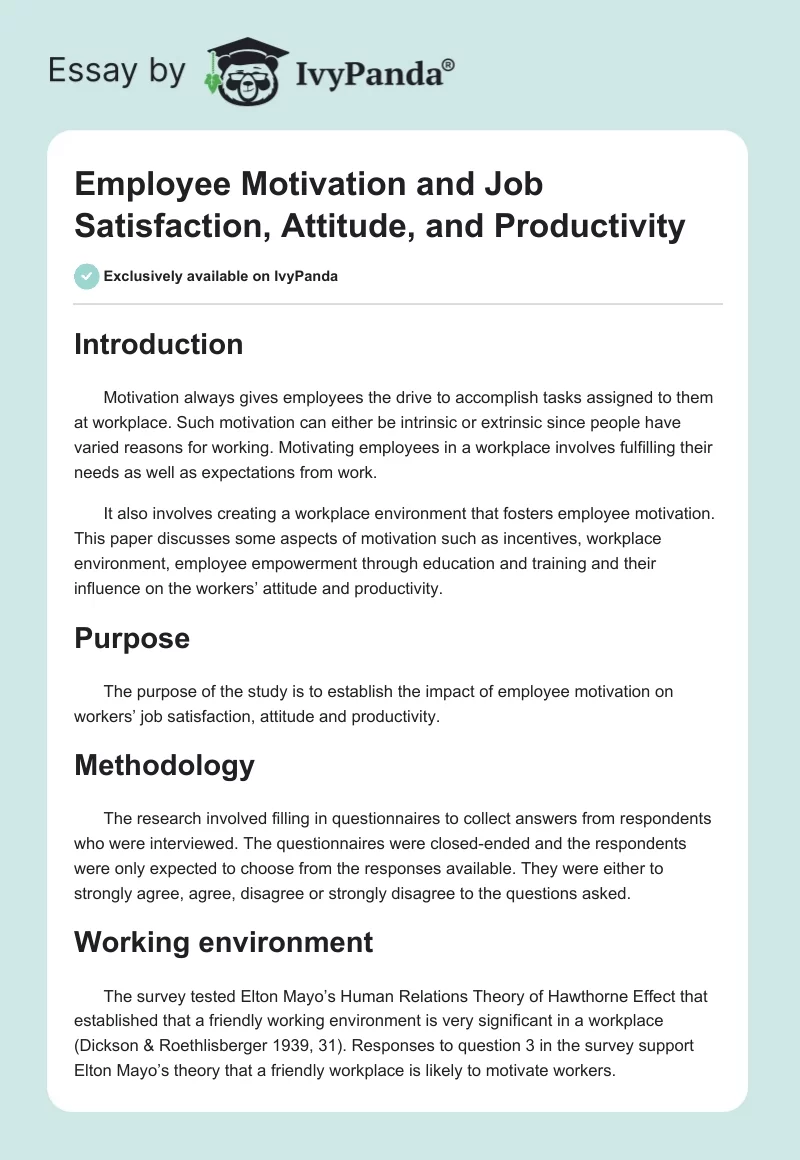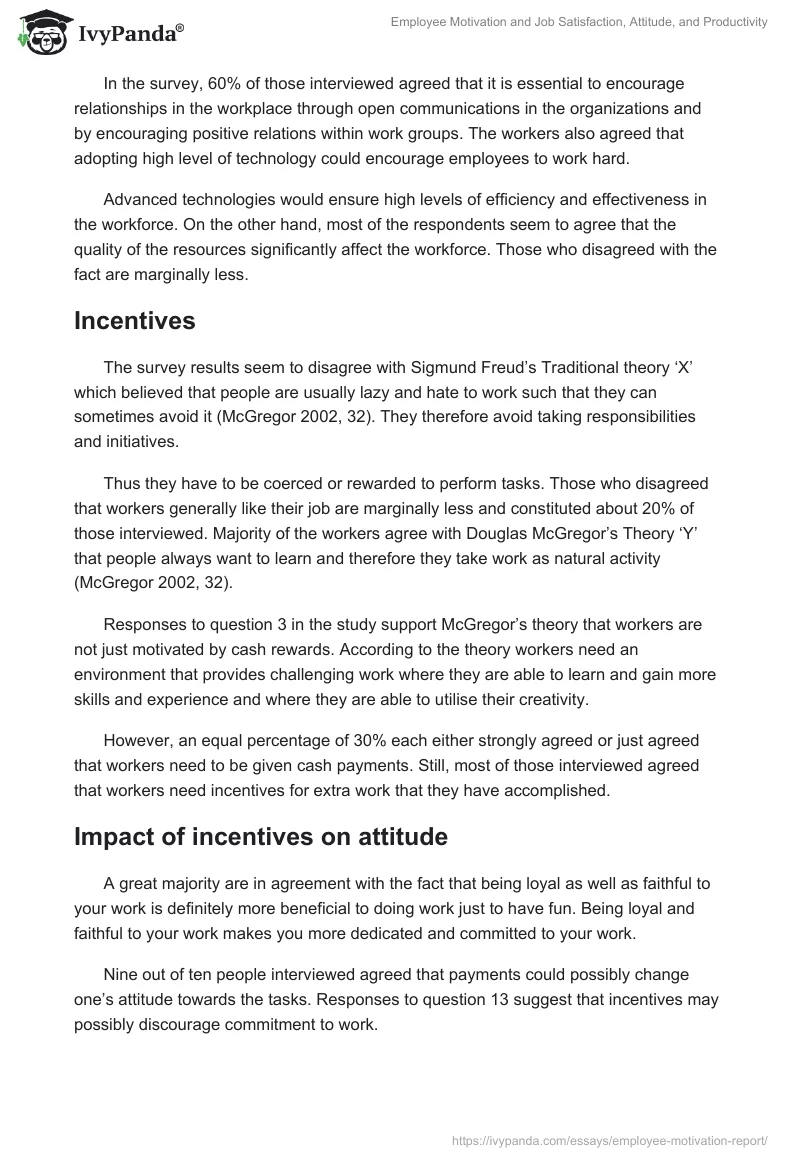Introduction
Motivation always gives employees the drive to accomplish tasks assigned to them at workplace. Such motivation can either be intrinsic or extrinsic since people have varied reasons for working. Motivating employees in a workplace involves fulfilling their needs as well as expectations from work.
It also involves creating a workplace environment that fosters employee motivation. This paper discusses some aspects of motivation such as incentives, workplace environment, employee empowerment through education and training and their influence on the workers’ attitude and productivity.
Purpose
The purpose of the study is to establish the impact of employee motivation on workers’ job satisfaction, attitude and productivity.
Methodology
The research involved filling in questionnaires to collect answers from respondents who were interviewed. The questionnaires were closed-ended and the respondents were only expected to choose from the responses available. They were either to strongly agree, agree, disagree or strongly disagree to the questions asked.
Working environment
The survey tested Elton Mayo’s Human Relations Theory of Hawthorne Effect that established that a friendly working environment is very significant in a workplace (Dickson & Roethlisberger 1939, 31). Responses to question 3 in the survey support Elton Mayo’s theory that a friendly workplace is likely to motivate workers.
In the survey, 60% of those interviewed agreed that it is essential to encourage relationships in the workplace through open communications in the organizations and by encouraging positive relations within work groups. The workers also agreed that adopting high level of technology could encourage employees to work hard.
Advanced technologies would ensure high levels of efficiency and effectiveness in the workforce. On the other hand, most of the respondents seem to agree that the quality of the resources significantly affect the workforce. Those who disagreed with the fact are marginally less.
Incentives
The survey results seem to disagree with Sigmund Freud’s Traditional theory ‘X’ which believed that people are usually lazy and hate to work such that they can sometimes avoid it (McGregor 2002, 32). They therefore avoid taking responsibilities and initiatives.
Thus they have to be coerced or rewarded to perform tasks. Those who disagreed that workers generally like their job are marginally less and constituted about 20% of those interviewed. Majority of the workers agree with Douglas McGregor’s Theory ‘Y’ that people always want to learn and therefore they take work as natural activity (McGregor 2002, 32).
Responses to question 3 in the study support McGregor’s theory that workers are not just motivated by cash rewards. According to the theory workers need an environment that provides challenging work where they are able to learn and gain more skills and experience and where they are able to utilise their creativity.
However, an equal percentage of 30% each either strongly agreed or just agreed that workers need to be given cash payments. Still, most of those interviewed agreed that workers need incentives for extra work that they have accomplished.
Impact of incentives on attitude
A great majority are in agreement with the fact that being loyal as well as faithful to your work is definitely more beneficial to doing work just to have fun. Being loyal and faithful to your work makes you more dedicated and committed to your work.
Nine out of ten people interviewed agreed that payments could possibly change one’s attitude towards the tasks. Responses to question 13 suggest that incentives may possibly discourage commitment to work.
People would not do the work to achieve the quality or goals of the company but to obtain rewards. This is also likely to create unhealthy competition in the workplace. It is also likely to change people’s attitude towards work.
Incentives in learning
Most of the participants agreed that incentives should also be applied in school learning for young children. Most people agree that learning has to be reinforced to achieve meaningful learning (Henderlong & Leper 2002, 781).
However, there seems to be a disagreement on whether young children should be rewarded in learning activities or play.
Training and development of employees
According to the results of the survey, a great percentage of those interviewed agreed to the fact that companies highly encourage and support education and training of workers.
Responses to question 7 significantly support Elton Mayo’s theory which believes that providing training to employees to improve their skills and experience and to provide new knowledge makes employees more efficient and they also feel valued by the company (Dickson & Roethlisberger 1939, 31).
This is supported by responses to question 9 where 20% and 40% of respondents strongly agree and agree respectively that unmotivated workers could be helped through training and guidance. Those interviewed barely disagreed with the fact that motivated workers are normally productive in any task assigned.
Majority of responses to question 10 agreed with the fact. The results of the survey seem to maintain the fact that managers should possibly offer jobs to their own people.
Although a good number of those interviewed disagreed with the idea, majority either agreed or strongly supported the fact that managers best understand what they want for the company and the roles each employee is supposed to play.
Extrinsic motivation
Extrinsic motivation may have long term effect on people’s approach to their jobs depending on how the reward system is managed. The results of the survey strongly show that reward system could be very effective in determining how people approach their job.
A small percentage refuted the fact that they often receive monetary incentives for doing outstanding work in their workplace. However, majority of those interviewed confirmed that they often receive monetary rewards for the same.
Monetary rewards may not have considerable long term effect on motivation since people have different goals whenever they get into work (McGraw 1978, 41). Responses to question 21 corroborated the fact that people would even perform better if given rewards for jobs they love doing. They would now do it for passion and for extra gains.
Intrinsic motivation
An equal majority either absolutely agreed or just agreed that self-management is significant as it helps a person develop his or her job as well as future life. The results also clearly demonstrated that a good majority also strongly believe that intelligence and experience are basic in achieving one’s goals.
According to Beswick (2007) intrinsic motivation is more important than extrinsic motivation since the former enhances creativity and self-determination to achieve a goal while extrinsic motivation is likely to suppress intrinsic motivation.
The results of the survey established the self-determination theory that believes that intrinsic motivation creates self-competence while extrinsic motivation may lead to unhealthy competition (Deci & Ryan 2000, 69).
Factors affecting workplace environment
The results in the table above have proven that a majority of people significantly agree that workplace environment affects people’s motivation.
Those who feel otherwise are marginally less implying that a friendly work environment with high levels of technology and quality resources for work or production are considerably valued by workers. A positive working environment has an impact on workers satisfaction and productivity.
Application of Incentives
The table above demonstrates that most people agree that incentives could be used to motivate workers. It shows that most people love their jobs and therefore incentives could be used to encourage positive performance and productivity.
However, there is a significant number that do not support the use of cash payments for rewards. Four out of ten of those interviewed disagreed with offering monetary incentives although they are all in consensus that incentives should be awarded for extra performance.
Education and training of employees
According to the results in the table above, a great majority agree that workers should be offered training and development so as to improve their job performance and productivity.
The results established that most people believe that providing training and development to workers could possibly improve their skills, knowledge and experience resulting into positive outcome.
Although the results also show that most companies support training and development of workers, a considerable majority still believe that managers should be given the opportunity to offer jobs to their own people.
Impacts of both intrinsic and extrinsic motivation on attitude of employees
The results in the table support the fact that incentives have a considerable influence on people’s attitude towards work. It clearly demonstrates that cash rewards could affect people’s perception towards tasks and can also discourage people’s intrinsic motivation towards work.
The results have confirmed that intrinsic motivation in work is better than doing jobs for rewards or just fun.
Extrinsic Motivation
Most people agree that monetary rewards are commonly used in the workplace according to the results above. The results have also verified that extrinsic motivation could produce long term effects.
This is backed up by the survey results which show that about 70% of those interviewed supported the fact that monetary rewards have long term effects while those who disagreed were marginally less.
Most people also agreed that incentives should be used in schools as reinforcement; however, the results barely proved whether it should be used for learning activities or play.
Intrinsic motivation
A good number of people agree that intrinsic motivation has a significant impact on job performance. Majority of people absolutely agree that self-management, intelligence and experience could help significantly in achieving both individual and company goals.
Furthermore, the results have also proven that intrinsic motivation has more value as compared to extrinsic motivation.
Conclusion
The results of the survey have proven that motivation whether intrinsic or extrinsic have an influence on employee satisfaction, productivity and job performance.
However, extrinsic motivation has to be carefully managed to realize long term effects. If not carefully managed, it could possibly suppress intrinsic motivation in individual workers.
Reference List
Beswick, D., 2007, Management implications of the interaction between intrinsic motivation and extrinsic rewards. Melbourne: University of Melbourne.
Deci, E., L., & Ryan, R., M., 2000, Self-determination theory and the facilitation of intrinsic motivation, social development, and well-being. American Psychologists 55 (1): 68-78. New York: Worth Publishers.
Dickson, W., J., & Roethlisberger, F., J., 1939, Management and the worker. Cambridge, MA: Harvard University Press. p. 31.
Henderlong, J., & Leper, M., R., 2002, The effects of praise on children’s intrinsic motivation: A review and synthesis. Psychological Bulletin 128: 774-795. New York: Sage Publishers.
McGraw, K., O., 1978, The detrimental effects of reward on performance: A literature review and prediction model. In Greene, D., E., & Lepper, M., R., 1978, The hidden costs of reward. Hillsdale, New Jersey: Erlbaum: pp.33-60.
McGregor, D., 2002, Theory X and theory Y, workforce. 81 (1): 32. New York: Blackwell Publishers.


